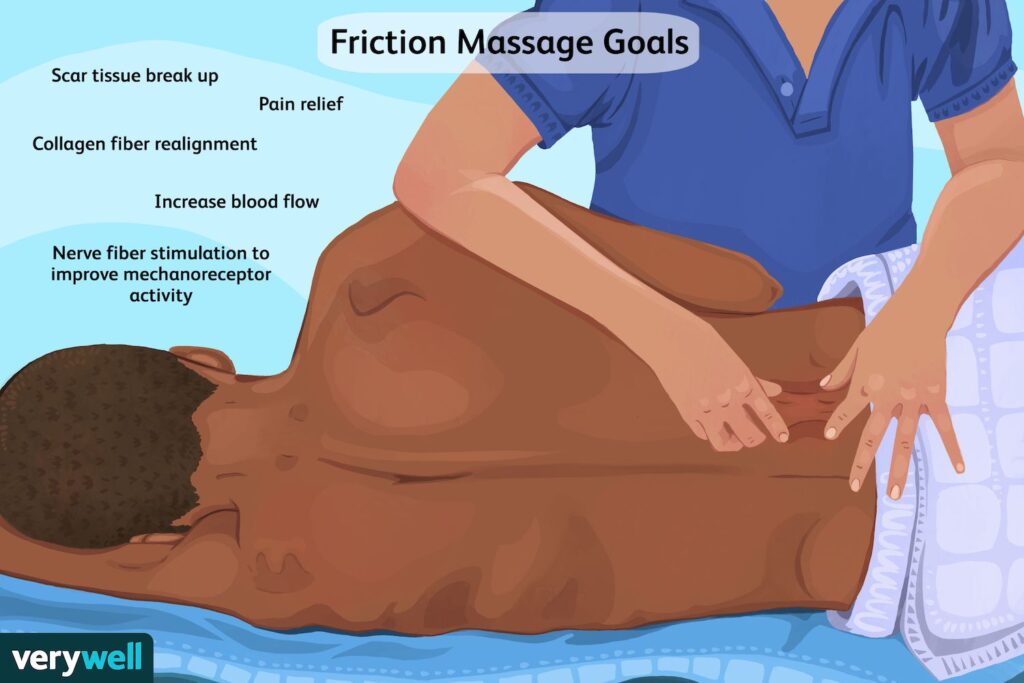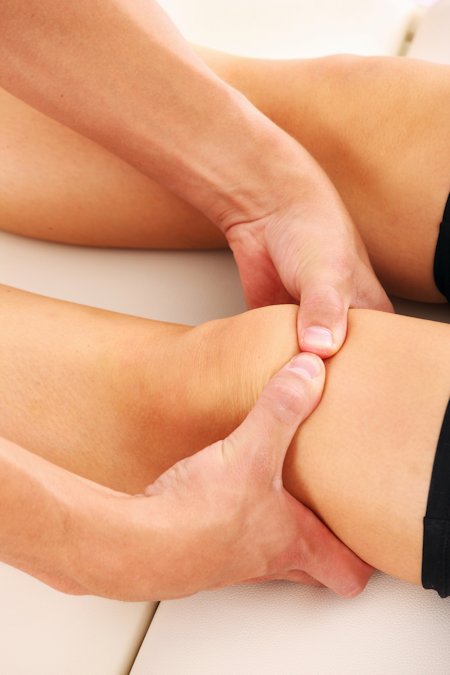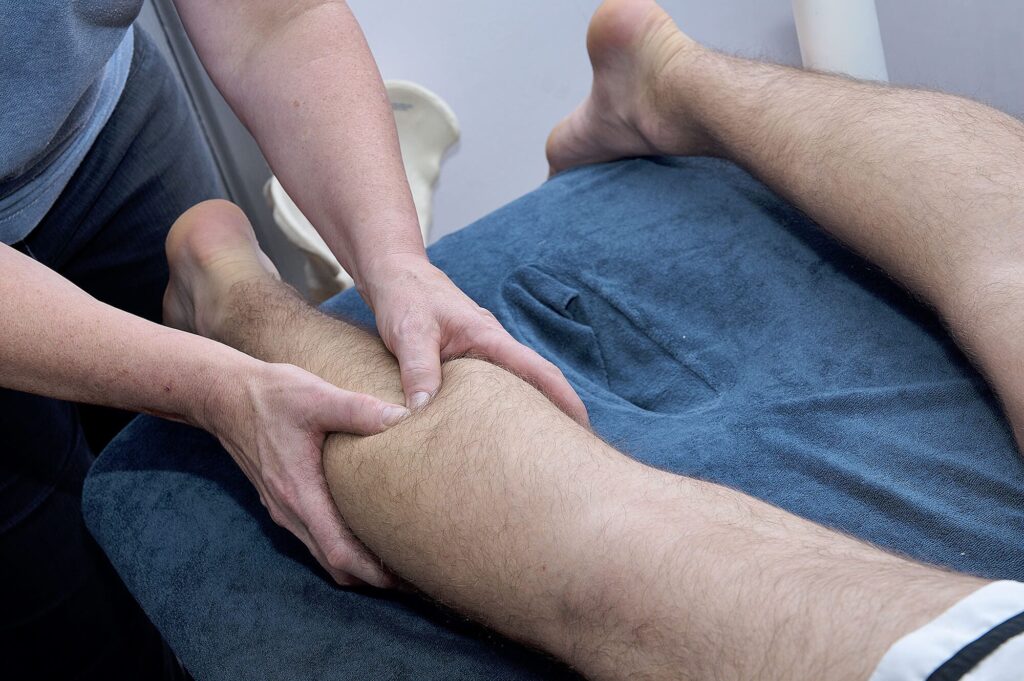Friction massage, a popular technique in the field of physical therapy, is known for its numerous benefits and versatile applications. By applying pressure and movement across the affected area using their hands or specialized tools, therapists employ friction massage to break down scar tissue, improve muscle flexibility, promote circulation, and reduce pain and inflammation. Whether you are an athlete recovering from a sports injury or an individual seeking relief from chronic muscle tension, friction massage can be a valuable tool in your rehabilitation and wellness journey.

This image is property of www.verywellhealth.com.
Relieving Muscle Tension
Muscle Knots
muscle knots, also known as myofascial trigger points, are areas of tightness and tension within the muscle fibers. These knots can be caused by a variety of factors, including poor posture, repetitive movements, or muscle overuse. They can lead to discomfort, pain, and restricted range of motion.
Friction massage is an effective technique for targeting and relieving muscle knots. By applying deep pressure and friction into the affected area, friction massage can help break up the knot and promote relaxation of the surrounding muscles. This can help alleviate discomfort and restore normal muscle function.
Trigger Points
Trigger points are specific areas within the muscle that are highly sensitive and can cause referred pain in other parts of the body. They can develop as a result of muscle overuse, trauma, or stress. Trigger points can lead to pain, muscle weakness, and restricted mobility.
Friction massage is a valuable technique for addressing trigger points. The deep pressure and friction applied during the massage can help release the tension in these specific points, providing relief from pain and allowing for improved muscle function.
Muscle Spasms
Muscle spasms are involuntary contractions of the muscle fibers that can be painful and debilitating. They can occur due to muscle fatigue, dehydration, or nerve irritation. Muscle spasms can disrupt daily activities and impact quality of life.
Friction massage can be an effective method for relieving muscle spasms. By applying targeted pressure and friction to the affected area, friction massage can relax the muscle fibers and alleviate the spasms. This can help restore normal muscle function and reduce discomfort.
Increasing Circulation
Stimulating Blood Flow
Good circulation is essential for the overall health and functioning of the body. It helps deliver oxygen and nutrients to the muscles and organs, promotes waste removal, and supports proper cell function. Poor circulation can result in muscle cramps, fatigue, and slow healing.
Friction massage is a technique that can stimulate blood flow and improve circulation. The deep pressure and friction applied during the massage can help dilate blood vessels, allowing for increased blood flow to the targeted area. This enhanced circulation can promote healing, reduce muscle tension, and contribute to overall well-being.
Enhancing Oxygen Delivery
Oxygen is vital for the proper functioning of muscles and tissues. It supports cellular respiration and energy production, allowing muscles to perform optimally. Insufficient oxygen supply to the muscles can lead to fatigue, weakness, and impaired performance.
Friction massage can help enhance oxygen delivery to the muscles. The combination of deep pressure and friction can increase blood flow, allowing for improved oxygenation of the tissues. This can result in enhanced muscle function, increased endurance, and improved athletic performance.
Reducing Scar Tissue
Post-Surgical Scars
After undergoing surgery, the body forms scar tissue as part of the healing process. However, excessive scar tissue can lead to limited mobility, pain, and functional limitations. Post-surgical scars can be challenging to manage and may require intervention to restore normal tissue function.
Friction massage can help reduce the formation of excessive scar tissue and minimize its impact on mobility. The targeted pressure and friction applied during the massage can break up adhesions and promote proper alignment of collagen fibers, resulting in a smoother and more flexible scar. This can improve range of motion, alleviate discomfort, and enhance post-surgical recovery.
Injury-Related Scars
Scars resulting from injuries, such as cuts, burns, or trauma, can also affect tissue function and mobility. They can become tight, thick, and adhered to surrounding tissues, limiting range of motion and causing discomfort.
Friction massage is beneficial for managing injury-related scars. The technique can help break down scar tissue, loosen adhesions, and improve tissue flexibility. By applying targeted pressure and friction, friction massage can promote the remodeling of scar tissue, allowing for better tissue mobility and reduced pain.
Improving Range of Motion
Joint Stiffness
Joint stiffness can occur due to various reasons, such as arthritis, overuse, or injury. It can restrict movement, cause discomfort, and impact daily activities. Restoring normal range of motion is crucial for maintaining joint health and function.
Friction massage can contribute to improving range of motion in stiff joints. By applying deep pressure and friction to the affected joint and surrounding tissues, friction massage can help break up adhesions, release muscle tension, and increase joint mobility. Regular friction massage sessions can lead to improved flexibility, reduced stiffness, and enhanced joint function.
Releasing Adhesions
Adhesions are bands of scar tissue that form between tissues or organs, limiting mobility and causing discomfort. They can develop after surgery, inflammation, or repetitive movements. Adhesions can restrict the proper sliding and gliding of tissues, resulting in decreased range of motion and pain.
Friction massage is effective in releasing adhesions and restoring tissue mobility. The targeted pressure and friction applied during the massage can help break up the adhesions and promote the realignment of collagen fibers. This can result in improved tissue flexibility, reduced pain, and increased range of motion.

This image is property of www.massageprocedures.com.
Alleviating Musculoskeletal Pain
Back Pain
Back pain is a common condition that can be caused by various factors, including muscle strain, poor posture, or spinal abnormalities. It can range from mild discomfort to severe pain, affecting daily activities and quality of life.
Friction massage can be a valuable technique for alleviating back pain. The deep pressure and friction applied to the affected muscles and tissues can help relax tight muscles, release trigger points, and improve circulation in the area. This can lead to pain relief, improved muscle function, and enhanced mobility.
Neck Pain
Neck pain is often associated with poor posture, muscle tightness, or injury. It can cause stiffness, limited range of motion, and headaches. Addressing neck pain is essential for maintaining proper posture, reducing discomfort, and preventing further complications.
Friction massage can help alleviate neck pain by targeting the muscles and tissues in the neck and shoulder area. The deep pressure and friction applied during the massage can help release muscle tension, improve blood flow, and promote relaxation. This can result in reduced pain, improved flexibility, and enhanced neck mobility.
Shoulder Pain
Shoulder pain can arise from various causes, such as muscle strain, tendonitis, or joint instability. It can restrict arm movement, cause weakness, and impact daily activities. Managing shoulder pain is crucial for maintaining upper body functionality and reducing discomfort.
Friction massage can be an effective technique for addressing shoulder pain. By targeting the muscles, tendons, and joints in the shoulder area, friction massage can help alleviate muscle tension, reduce inflammation, and promote healing. This can lead to improved shoulder mobility, increased strength, and reduced pain.
Knee Pain
Knee pain can be caused by conditions such as arthritis, ligament sprains, or overuse injuries. It can affect mobility, cause swelling, and interfere with normal activities. Managing knee pain is important for maintaining lower body functionality and preventing further damage.
Friction massage can help alleviate knee pain by targeting the muscles and soft tissues around the knee joint. The deep pressure and friction applied during the massage can help reduce muscle tension, improve circulation, and promote healing. This can result in reduced pain, improved range of motion, and enhanced knee function.
Promoting Relaxation
Relieving Stress
Stress can have a negative impact on both physical and mental well-being. It can lead to muscle tension, headaches, and a sense of unease. Finding ways to relieve stress is crucial for maintaining a healthy and balanced lifestyle.
Friction massage can aid in stress relief by promoting relaxation of the muscles and the release of endorphins, which are natural mood-enhancing chemicals. The deep pressure and friction applied during the massage can help reduce muscle tightness, relieve tension, and induce a state of deep relaxation. This can help alleviate stress, improve sleep quality, and enhance overall well-being.
Enhancing Well-being
In addition to relieving stress, friction massage can contribute to overall well-being. Regular sessions can help improve blood flow, release endorphins, and promote a sense of calm and relaxation. Friction massage can also help relieve muscle tension, enhance flexibility, and reduce discomfort. By incorporating friction massage into your self-care routine, you can support your physical and mental well-being, leading to a healthier and more balanced lifestyle.

This image is property of www.kilkennyphysioclinic.com.
Enhancing Sports Performance
Preventing Injuries
Injuries are a common occurrence in sports and can hinder performance and lead to downtime. Preventing injuries is crucial for athletes to maintain their training consistency and reach their full potential.
Friction massage can contribute to injury prevention by improving muscle flexibility, releasing muscle tension, and enhancing blood flow to the targeted muscles. By incorporating regular friction massage into a training routine, athletes can reduce the risk of muscle strains, minimize tightness, and optimize overall muscle function.
Facilitating Recovery
Sports-related injuries and intense training can cause muscle soreness and fatigue. Facilitating a speedy recovery is essential for athletes to return to peak performance and minimize training interruptions.
Friction massage can help facilitate recovery by promoting increased blood flow to the muscles, reducing inflammation, and speeding up the removal of metabolic waste products. The targeted pressure and friction applied during the massage can help relax tight muscles, alleviate soreness, and enhance the body’s natural healing processes. Regular friction massage sessions can aid in faster recovery, improved muscle function, and enhanced sports performance.
Aiding Rehabilitation
Physical Therapy
Physical therapy plays a vital role in the rehabilitation of injuries and the restoration of proper function. Friction massage can be a valuable technique used by physical therapists to help patients recover from various conditions, such as muscle strains, ligament sprains, or post-surgical rehabilitation.
By applying targeted pressure and friction to the affected areas, friction massage can help reduce pain, improve range of motion, and promote tissue healing. It can aid in breaking up scar tissue, releasing muscle tension, and improving overall mobility. Friction massage, when used in conjunction with other physical therapy techniques, can contribute to successful rehabilitation outcomes.
Post-Workout Recovery
After a strenuous workout, the body requires adequate recovery to repair and rebuild muscles. Friction massage can be incorporated into post-workout recovery routines to enhance muscle recovery and reduce muscle soreness.
By applying targeted pressure and friction to the muscles, friction massage can help flush out metabolic waste products, increase blood flow to the muscles, and reduce post-exercise inflammation. This can promote faster recovery, minimize muscle soreness, and enhance the body’s ability to adapt to training stimuli.

This image is property of www.physio.co.uk.
Addressing Myofascial Pain Syndrome
Trigger Points
Myofascial pain syndrome is a condition characterized by the presence of trigger points within the muscles. These trigger points are highly sensitive areas that can cause localized or referred pain. Myofascial pain syndrome can be caused by trauma, muscle overuse, or stress.
Friction massage is an effective technique for addressing myofascial pain syndrome. By applying deep pressure and friction to the trigger points, friction massage can help release muscle tension, alleviate pain, and restore normal muscle function. Regular friction massage sessions can contribute to the reduction of trigger point sensitivity and the management of myofascial pain syndrome.
Tightness
Myofascial pain syndrome is often associated with muscle tightness, which can lead to restricted range of motion, discomfort, and impaired muscle function. Adhered fascia and muscle fibers can contribute to the development of tightness within the muscles.
Friction massage can help address tightness by targeting the affected muscles and applying deep pressure and friction. This technique can help break up adhesions, release muscle tension, and improve tissue flexibility. Friction massage can promote the relaxation of tight muscles, alleviate discomfort, and contribute to improved overall muscle function.
Managing Plantar Fasciitis
Heel Pain
Plantar fasciitis is a common condition that causes heel pain. It occurs due to inflammation and irritation of the plantar fascia, a thick band of tissue that runs along the bottom of the foot. Heel pain can be sharp, stabbing, or throbbing, making walking and other activities uncomfortable.
Friction massage can be an effective technique for managing heel pain caused by plantar fasciitis. By applying deep pressure and friction to the affected area, friction massage can help reduce inflammation, release muscle tension, and promote healing. Regular friction massage sessions can contribute to pain reduction, improved foot mobility, and enhanced quality of life.
Reducing Inflammation
Inflammation is a key component of plantar fasciitis and can contribute to persistent heel pain. Decreasing inflammation is crucial for managing the symptoms and promoting tissue healing.
Friction massage can help reduce inflammation associated with plantar fasciitis. The targeted pressure and friction applied during the massage can help increase blood flow, promote lymphatic drainage, and decrease the production of pro-inflammatory substances. This can lead to reduced pain, improved tissue healing, and enhanced function of the foot.
In conclusion, friction massage is a versatile technique that can benefit individuals in various ways. From relieving muscle tension and reducing scar tissue to promoting relaxation and enhancing sports performance, friction massage offers a range of therapeutic benefits. Whether you are seeking pain relief, improved mobility, or overall well-being, incorporating friction massage into your self-care routine can be a valuable addition. Consult with a licensed massage therapist or healthcare professional to receive the most appropriate and effective friction massage treatment tailored to your specific needs.

This image is property of www.massageprocedures.com.
